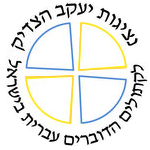Hebrew spoken here
“One”, the journal of the Catholic Near East Welfare Association (CNEWA), has a feature article in its Spring 2013 edition on the Hebrew speaking Catholic kehillot in Israel.

In a long feature article, journalist Michele Chabin describes the life of the community and its faithful. The article can be read here on the CNEWA site
In 1990, when Michal Reich’s parents no longer felt they had a future in post-revolution Romania, they decided to move to Israel.
Although they were practicing Catholics, her paternal grandfather was Jewish, and under Israel’s “Law of Return” policy, people who can prove they had at least one Jewish grandparent are entitled to settle there.
Determined to succeed in Israel, Michal Reich, then 13, attended a regular state school, where the language of instruction was Hebrew. At 18, she performed mandatory Israeli military service.
“Most of the soldiers knew I was a Christian and no one had a problem with it,” she recalls. A petite woman with dark hair, Michal sits in her small Jerusalem apartment with her newborn daughter Josephine nestled in her arms, nursing.
While Mrs. Reich, now 34, integrated almost seamlessly into mainstream Israeli society, finding a spiritual home proved more difficult. Unlike the majority of indigenous Holy Land Christians, she did not speak Arabic. She understood the Romanian prayers at her parents’ church, but most of the worshipers were foreign workers with no roots in Israel.
“I went to a lot of churches, but it wasn’t until six or seven years ago that we discovered the Hebrew-speaking Catholic community in Israel,” Mrs. Reich says, smiling at her husband, Doro, who is also from Romania. “The services in Jerusalem are unique. They’re small and intimate and the people are modest and unassuming, even if they’re professors.
“We care about each other like a family,” she says.
By any measure, it may be one of the most distinct cultures in all of Israel. With just 500 active members, including children, Israel’s Hebrew-speaking Catholic community is so small that many Catholics around the world, and most Israelis, do not know of its existence. It endures as a vibrant contradistinction: Catholics celebrating their faith in a country that is overwhelmingly Jewish, worshiping in Hebrew, marking Jewish feasts and traditions, and honoring many local customs. Yet they are undeniably, proudly Catholic.
The community was born in 1955. That year, a group of Catholics in Israel founded a pious association called the Work of St. James to help Hebrew-speaking Catholics live their faith in a Jewish society.
“The church began to realize there were thousands of Catholics in Israel who were not Arabs and not expatriates, who belonged to and integrated into Hebrew-speaking, Jewish Israeli society,” says the Rev. David Neuhaus, Latin patriarchal vicar of Hebrew-speaking Catholics.
Some were married to Jews, while others were from Catholic branches of predominantly Jewish families. A smaller number were Jews who, like Father Neuhaus, had converted to Catholicism.
Regardless of their backgrounds, most “strongly saw themselves as Jewish historically, ethnically and culturally, and at the same time Catholic,” he says.
But between the 1950’s and the 1980’s, the community dwindled dramatically, largely due to emigration and assimilation.
“Some people felt it was impossible to live a Catholic life without being an Arab,” Father Neuhaus explains, noting that many Catholic institutions in the Holy Land, including schools, hospitals and rest homes, are designed to serve the Arab community.
Assimilation was and remains an even more ominous threat. “It’s our biggest challenge,” the Jesuit admits, sitting in the beautiful old stone house in downtown Jerusalem that serves as a church and living quarters for the vicar and his support staff.
“Our faithful are predominantly integrated into secular Israeli Jewish society and the pull toward secularism is very strong.”
Although it is open to new members, the community does not engage in missionary activity out of respect for the local population and Israeli law. Nor does it recruit from among the country’s thousands of Messianic Jews — Jews who believe that Jesus is the messiah — who have their own congregations.
To help reinvigorate the community and recognize its uniqueness, in 1990 the Holy See designated it a vicariate of the Latin Patriarchate of Jerusalem. This official recognition gave the St. James Vicariate for Hebrew-speaking Catholics representation in official matters of the Latin Church and a deep feeling of belonging to the global church.
“It makes sense that they have a special body that takes care of their needs,” says Bishop William Shomali, auxiliary bishop and patriarchal vicar for Palestine. “Hebrew isn’t just a language; it’s a culture. When someone lives in Israel, in a Jewish context, he reads Israeli newspapers and is part of the majority. At the same time, Hebrew-speaking Catholics are a distinct minority.”
While members of the community come from a variety of backgrounds, all find unity in the most familiar form of Catholic worship, the Mass in the Latin rite, celebrated in Hebrew in six communities across Israel. As Father Neuhaus explains, it is the same Mass prayed around the world, but “with minor concessions to the particularity of praying in Hebrew.”
On Sundays, for example, the liturgy begins by lighting two candles representing the Old and New Testaments, signifying “their intimate unity.” The music is inspired by both Christian and Jewish traditions rooted in the region. Readings from the Old Testament, including the Psalms, are heard in their entirety, rather than selected verses, and Jewish feasts and days of commemoration are mentioned.
“Needless to say, praying in Hebrew brings out very forcefully the resonances in the liturgy with the biblical texts, particularly of the Old Testament,” Father Neuhaus says, after celebrating a weekday Mass at the Jerusalem chapel.
One of the challenges is to continue making the faith resonate, especially among the young. In most Catholic communities around the world, “even the children who stop coming to church return to get married and to baptize their children,” Father Neuhaus notes.
“With us, it’s completely different. Once our children stop coming to church, we never see them again.
“The church,” he adds, “becomes invisible in their lives.”
The community offers a five-day summer camp and a three-day spring retreat. It has also created a set of three Hebrew-language catechism books that weave together both Catholic and Jewish teachings and traditions. Before Mass, teachers in the community offer classes in religious education.
To make the church relevant to children — and to recall Jesus’ life as a Jew — the community offers a retreat on Yom Kippur, the Jewish Day of Atonement, and hosts a big get-together on Sukkot, the feast of the Tabernacles.
“We are aware these are events that were celebrated by Jesus and they punctuate the time of the society in which we live,” Father Neuhaus says.
Hebrew-speaking Catholics are acutely aware that some Jews and Arabs — including Christians — may misunderstand their motives. They are fearful, too, of religious extremists, who on occasion have desecrated church properties. The community tries to maintain a low profile and to keep outward Christian symbols to a minimum.
“We know that external signs of Christianity, and particularly the cross, arouse warm feelings of belonging among Christians, but that is not always the case with Jews, who might have vivid and traumatic memories of European anti-Semitism,” Father Neuhaus says.
Complicating matters further, Israeli and Palestinian Arab Christians often do not understand how Catholics can support the state of Israel.
The Arab Christian community “is a traumatized community” because of the displacement of so many Palestinians, Father Neuhaus notes. “We live in a country full of friction, we on the Israeli Jewish side and many of our Catholic brothers and sisters on the Palestinian side, so this friction is present in the church as well. “The challenge,” he concludes, “is to live the unity of the Body of Christ despite the divisions of politics, violence and war.”
The community is also engaged in less-controversial outreach — to Israel’s Christian migrant population.
While the children hail from various countries, many were educated in Israel. Hebrew is often the only language they can read. These children have access to Hebrew catechism books and religion classes. A small number are able to attend the five-day summer camp.
“All of this takes up an enormous part of our energy and resources,” Father Neuhaus notes, sounding a bit weary.
Resources are limited. Many members of the vicariate are working class and barely scrape by.
As much as they want to, it is hard for them to donate money.
Due to its own financial constraints, the Latin Patriarchate has given its Hebrew-speaking vicariate “almost nothing,” Bishop Shomali says. “So far, they’ve had to manage things themselves by fundraising. We have to help them but lack the money to do so. At the very least, we can introduce them to various Catholic organizations.”
The community is dependent on the generosity of benefactors, and has received some support from collaboration with CNEWA and the Equestrian Order of the Holy Sepulchre of Jerusalem, a chivalric order of the Catholic Church that supports the Latin Patriarchate. It also receives small sums from Catholic aid associations for specific projects. The vicariate receives no money whatsoever from the Israeli government.
While the community’s members are extremely grateful for everything they have — and some have very little by Israeli standards — they dream of a time when their church will be able to offer more, especially for young people.
In her ground-floor home in the southern city of Beersheva, Mariana Assy, a 40-year-old mother of four, hopes that some of the Arabic-language Christian texts she used as a schoolgirl in the Christian Arab town of Fasuta, in the north, will one day be translated into Hebrew.
Seated in her cheery living room, Mrs. Assy explains that her children have never learned to read or write in Arabic. “We moved from the north to the south to find work before the children were born,” Mrs. Assy, a teacher says. Her husband, Raphael, is a chemical engineer. Until relatively recently, she explains, “there was no Arabic-language school in Beersheva” — though there is now a Hebrew-Arabic academy — “which left only Hebrew-language schools.
“Our children know some Arabic, but don’t understand enough to attend Arabic services,” she notes. “And anyway, there is no Arab Catholic church in Beersheva.”
Nearby, in her tiny apartment on the 14th floor of a run-down building, Marian Rashed, an Arab Catholic teacher originally from the north of the country, breaks into a smile at the mention of the catechism class she offers the community’s youth.
“If we had the money we would use it to develop ourselves,” she says.
“I’d start with more educational opportunities, of course. Maybe rent a bigger place to hold services. You can be sure we wouldn’t use it to build a bell tower or a cathedral!”












 The Return of the Wall Guardians of Jerusalem
The Return of the Wall Guardians of Jerusalem